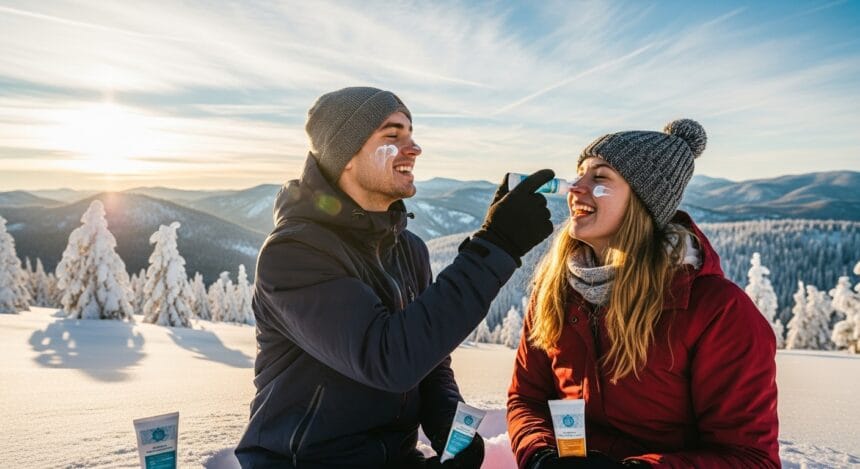Health Works Collective has long focused on bringing attention to seasonal health issues that often go unnoticed, and UV protection during the colder months is one of them. Many people assume that ultraviolet exposure is only a concern in the summer, but winter’s reflective snow and thinner ozone layer can make the sun’s rays just as harmful. You may think cloudy skies mean safety from UV damage, but up to 80% of the rays can still penetrate clouds. It is easy to forget sunscreen when bundled up, yet unprotected skin is still at risk.
- Indoor and winter UV are still risks
- Choose and use sunscreen correctly—indoors and on cold days
- Build a year-round routine for home, office, and travel
- Let the UV Index guide daily choices—even in winter
- Windows, cars, and glass: practical fixes for UVA
- Re-apply and re-check: making protection stick
- Final thoughts: keep it simple and steady
Even though the air feels cool, UV radiation remains a year-round danger that quietly affects skin health. We talked about using smartphones to identify skin cancer risks, but knowing how to prevent it is also important. There are days in winter when UV levels can be as high as during summer because of snow reflection and altitude. You may not feel the heat of the sun, but that does not mean your skin is safe. Keep reading to learn more.
Understanding the Risks and Science Behind UV Damage
The Skin Cancer Foundation reports that in the U.S., more than 9,500 people are diagnosed with skin cancer every day. That staggering number shows that UV exposure is not a minor issue confined to sunny beaches. You are exposed even while driving, walking the dog, or skiing on a bright day. It is easy to underestimate the damage because sunburns are less visible in cold weather.
A report from the Centers for Disease Control and Prevention reveals that skin cancer treatments cost $8.9 billion a year. Those costs include surgeries, medications, and long-term care that could often be reduced with better UV protection habits. You might save money and protect your health by simply applying sunscreen daily. There are many economic and personal reasons to take UV exposure seriously.
Megan Sander, MD, of the Department of Medicine Section of Dermatology at the Cumming School of Medicine, published a study highlighting how effective proper UV protection can be. Her work shows that high-quality evidence supports the major benefits of sunscreen use in preventing skin cancer. You can think of sunscreen not just as a summer accessory, but as a year-round health tool. It is remarkable how small daily actions can have large long-term benefits.
Dr. Sander also explains how different sunscreen ingredients work to protect the skin. “Physical sunscreen filters like titanium dioxide and zinc oxide reflect or refract ultraviolet radiation away. You might not realize that when these minerals are micronized, they also absorb light like chemical filters. It is fascinating that such tiny particles can play such a major role in cancer prevention.”
There are unique factors in winter that make UV rays more intense than many expect. Snow can reflect up to 80% of the rays, essentially doubling exposure for anyone outdoors. You may think a hat or scarf offers enough protection, but reflected light reaches the face and neck easily. It is a mistake to rely solely on clothing for coverage.
You can take simple steps to protect yourself during the winter months. There are broad-spectrum sunscreens made for cold climates that prevent both UVA and UVB damage. It is smart to apply them on any exposed skin, especially before skiing, hiking, or even running errands. You will find that routine protection keeps your skin healthier over time.
It is clear that skin cancer prevention depends on consistent habits rather than seasonal effort. You might find it helpful to keep sunscreen near your moisturizer or daily skincare products to remember to use it. There are easy ways to make sun protection a part of your morning routine. You are investing in both appearance and long-term wellness when you do.
The message is simple: UV protection is not just for summer vacations or beach days. You are exposed every time you step outside, regardless of temperature or weather. It is far easier to prevent damage than to treat it after it appears. Maintaining UV protection in winter is one of the simplest forms of self-care you can practice.
Most people reach for sunscreen when it’s hot, sunny, and they’re headed outdoors. But that assumption skips a crucial detail: UV exposure doesn’t stop indoors or in winter. Whether you’re driving, skiing, working by a sunny window, or just out on a brisk day, UVA rays still reach your skin—and they do damage all year long.
In this guide, we’ll break down:
- Why indoor and winter UV still matter
- How to choose and apply sunscreen properly
- How to use the UV Index and daily habits to stay protected
Indoor and winter UV are still risks
Sun exposure doesn’t stop indoors or in winter.
UVA rays, unlike UVB, can penetrate glass—meaning your skin is still exposed near windows, in your car, or even on an overcast day. Snow reflects up to 80% of UV rays, and higher elevations increase UV strength. So whether you’re by the window at work or on the slopes, your skin is still in harm’s way.
It’s not just theory. The CDC guidance on reducing skin cancer risk outlines the need for protection across all seasons. Protective steps include wearing long sleeves, using sunscreen on exposed areas, and limiting midday exposure—even in colder months. If you’re still not convinced, here are several well-supported reasons to wear sunscreen indoors—many of which may surprise you.
UVA vs UVB in one minute
UVA rays age skin and penetrate deeper; UVB causes burns. Most indoor glass blocks UVB but not UVA.
Winter reflectance
Snow glare, water, and even concrete amplify UV reflection. Winter sports enthusiasts, take note.
- Side window in your car? UVA gets through.
- Desk facing south? You’re exposed.
- Skiing in January? UV can be just as high as summer.
Choose and use sunscreen correctly—indoors and on cold days
Label choices and application matter more than the season.
Dermatologists recommend using broad-spectrum SPF 30+ sunscreen every day, year-round. Even if you don’t burn easily, UVA still causes long-term skin damage. If you’re moving between indoors and outdoors—or commuting, exercising, or working near windows—you’re still at risk.
Not all sunscreens are created equal. Understanding how to decode sunscreen labels is key. Look for:
- Broad-spectrum (protects against both UVA and UVB)
- Water-resistant if you sweat or commute
- SPF 30 or higher
Amounts & missed spots
Most people under-apply. Use a nickel-sized amount for your face, and don’t forget ears, hands, and hairline.
Mineral vs chemical
Both protect well when used properly. Choose the type that suits your skin and preferences.
Quick routine:
- Cleanse and dry your face.
- Apply broad-spectrum SPF 30+ to all exposed skin.
- Reapply every 2 hours or after heavy sweating.
A winter gym commute or window-side office hours still call for daily protection.
Build a year-round routine for home, office, and travel
Simple, repeatable habits make protection stick.
Start your day by checking the UV Index. Keep sunscreen in your bag, desk, or glovebox. Lip balm with SPF, sunglasses, and travel-sized sunscreen should be part of your daily carry. For practical tips to protect your skin year-round, think beyond the beach and build skin protection into your everyday environment.
You can pair sunscreen habits with winter routines: apply before putting on gloves or stepping out with your coffee.
Car and commute
Side windows let UVA through. Use sunglasses, gloves, and apply SPF before driving.
Office/home setup
Reposition your desk if it gets strong midday sun. Use shades or blinds as needed.
Commuter/desk kit:
- Lip balm with SPF
- Travel sunscreen
- UV-rated sunglasses
- Hand cream with SPF
Whether you’re working from a sunlit kitchen or commuting at noon, the right routine reduces year-round exposure.
Let the UV Index guide daily choices—even in winter
The UV Index translates risk into actions you can follow.
Developed by the EPA, the UV Index scale runs from 0 to 11+. It factors in your location, season, cloud cover, and more. Even in winter, a high UVI means protection is a must.
Most weather apps include the UVI—check it alongside the temperature. Anything over 3 means it’s time for sunscreen and protective gear. These small steps also align with broader tips to keep your skin healthy, especially during transitional seasons.
Reading the scale
Here’s a quick guide:
| UVI Range | What to Do |
| 1–2 | Minimal risk; SPF optional for short exposure |
| 3–5 | Moderate; wear SPF, hat, sunglasses |
| 6–7 | High; seek shade midday |
| 8–10 | Very high; extra measures (UPF clothing, avoid peak hours) |
| 11+ | Extreme; avoid direct sun, double up protection |
Make checking the UV Index part of your morning routine—it’s a quick, protective habit.
Windows, cars, and glass: practical fixes for UVA
Small adjustments reduce indoor and in-car exposure.
Repositioning your seat just a metre from direct sun can make a difference. Add sheer curtains, window films, or UV-protective coatings if you work near glass. UV-rated sunglasses help too—especially while driving or walking during daylight.
In winter, snow glare adds a double hit. Higher elevations and reflective surfaces mean UV isn’t just a summer problem.
Quick fixes:
- Shift your desk from sunny spots.
- Use blinds or window film.
- Wear sunglasses year-round.
- Add SPF hand cream to your winter routine.
These aren’t major life changes—but they help create an environment that supports your skin.
Re-apply and re-check: making protection stick
Consistency beats intensity for long-term skin health.
Set app reminders or link reapplication to daily cues—after lunch, before a walk, or following hand sanitiser use. SPF lip balm and hand creams can live in your coat pocket or bag for quick touch-ups.
Habit hooks:
- After lunch = face check + SPF top-up
- Before commute = gloves, glasses, reapply
A ski trip or work-from-window day calls for re-checking your routine. It’s easier than you think.
Final thoughts: keep it simple and steady
Protecting your skin indoors and in winter doesn’t require complicated regimens—just smart, daily actions.
- Check the UV Index and plan accordingly
- Use broad-spectrum SPF 30+ correctly, every day
- Keep a commute/desk kit for easy reapplication
- Reassess your setup when seasons or routines change
By treating skin protection as a habit, not a hassle, you’ll stay safer—no matter the season.
Winter UV protection is about consistency and awareness, not just reacting to visible sunlight. You have the power to prevent long-term damage by staying mindful of UV exposure all year.
The science, cost data, and expert research all point to one truth — daily sunscreen use saves lives and reduces suffering. There is no off-season for protecting your skin from ultraviolet radiation.










